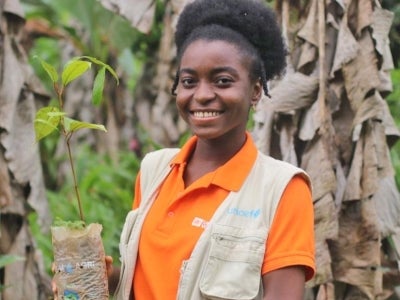
Photo courtesy of Taylor Guitars
Bob Taylor is the founder of Taylor Guitars, one of the largest manufacturers of acoustic guitars in the United States. In an interview, he shared the reasons his company is working with the Global Environment Facility through The Ebony Project to invest in the socially responsible and environmentally sustainable model of sourcing Central African ebony trees.
What do you do for a living?
I’ve enjoyed a fulfilling career as a guitar maker. I started this company with a partner when I was 19 years old, in 1974. The company has grown to about 1,300 people with direct operations in Cameroon, Holland, Japan, and the United States, including Hawaii. We sell our guitars nearly everywhere.
How is guitar making affected by the environment?
My line of work is making and selling guitars. But I live in this era of rapidly diminishing forest resources and the exposure of mankind’s over-harvesting without regard to regeneration. I’m trying to do the right thing. That includes paying for the sins of my fathers as well as investing in a future where musical instruments can continue to exist in their best form. The mantle of responsibility fell upon me slowly but surely, and I’ve responded. The Ebony Project is but one of my responses.
What does The Ebony Project involve?
Our company, Taylor Guitars, uses ebony for two components of our guitars, as do most of the stringed instrument makers worldwide. Seven years ago, we started The Ebony Project in Cameroon as an investment in the botany, horticulture, and ecology of the Central African ebony tree (Diospyros crassifloria Hiern). I’ve personally spent around $3 million to fund this project. The Congo Basin Institute in Yaoundé, Cameroon, is providing the boots on the ground and the science. We are working to scientifically understand and also to plant these trees, as well as fruit trees, at the village level and in remote locations. To date, we’ve planted 35,499 ebony trees and 16,910 fruit trees in Cameroon. More will be planted next year. And the year after that. This has been a very successful project as it addresses not only the planting of this valuable tree, but also food security, income, and even property rights.
I’m very happy that this work in Cameroon has been attractive enough to some onlookers to help support its spread. I started this project never thinking any support would ever come our way. The GEF has recently directed about $1 million toward our project and we are now working together towards shared goals for these trees and their ecosystem. Thank you from the bottom of my heart for joining me in this work. I would also like to thank the authorities in Cameroon who endorsed the GEF project with the support of WWF-US.

Photo courtesy of Taylor Guitars
Is there someone you have met through your work who has had a lasting impact on you?
Many. Tom Smith and Virginia Zaunbreacher of UCLA. Scott Paul, my Director of Natural Resource Sustainability (former Director of Greenpeace Forest Campaign) at Taylor Guitars. Zac Tchoundjeu of IBAY SUP in Yaoundé. Vincent Deblauwe, our Belgian biologist living in Yaoundé, who works on The Ebony Project. Zac Emenda, a bright young man in Yaoundé, who was the guard at my house there, whom I offered a scholarship for his education, and who has earned a master’s degree in agroforestry and now works on The Ebony Project. Vidal de Teresa, my Spanish partner in our ebony sawmill in Yaoundé, without whom The Ebony Project wouldn’t exist. Luisa Willsher, my partner from Spain who tirelessly sells the idea to musical instrument makers worldwide that ebony doesn’t have to be pure black to be acceptable. These are but a few examples of the the kind of people humans should be.
What life lessons has your work taught you?
That with a little effort building a small team, the world can be changed.
Environmental issues are very often complicated and concerning. What gives you hope?
All issues are complicated. That’s why they are issues. Humanity cannot improve their lot without using the environment. So, yes, it’s impossibly complicated. But succeed or fail, one should work to leave the next generation more choices than the current generation. Simply being an example of what can be done on a small scale in order to give larger operators some ideas they haven’t implemented or even thought of gives me hope.


